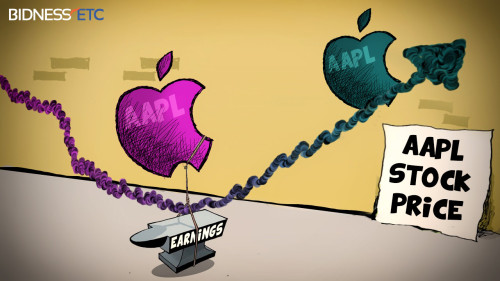About
Bidness Etc
Bidness Etc is a New Age Platform For The Latest In Finance & Everything Else
+ FOLLOW THIS TUMBLRHow Long Will it Take Apple to Overcome the Earnings Slump?
Despite the recent weakness, Bidness Etc believes Apple stock should be back to pre-earnings levels in less than a month

Apple stock has shed over 5% since its second-quarter earnings results were announced on Monday, April 27. This happened even as the iPhone continued to see rising demand. The company sold 61.2 million iPhones in the March quarter, exceeding consensus estimates of around 58 million units, with higher phone ASPs driving brisk revenue and an EPS beat. ASPs were up $62 year-over-year to $659.
The earnings impressed almost every analyst on Wall Street, with the stock hitting an all-time high of $134.54 in early trading on Tuesday. But shares have since slumped in what has been a bad week for broader markets, as investors booked profits. Skeptics are out in force, saying that the stock may be in for a bit of a correction given its unprecedented 53% surge since April 2014, while others are still warning of an impending slowdown in smartphone sales that could hit the iPhone maker in the coming quarter.
This Has Happened Before
Yesterday, Apple stock broke below the closely watched 50 day moving average of $127.10 only the second time since late January that this has occurred. It closed the day down 2.71% to $125.15. The stock’s movement may baffle some investors, given the overly positive outlook on the Street and true to historical trends, Apple shares rallied ahead of their earnings announcement.
Apple shares have had a tendency to surge ahead of earnings announcements. This time around the stock rose 6.3% over six trading sessions in the run up to the quarterly report. Last year, a week ahead of Apple’s quarterly release for the first quarter of fiscal 2014 on January 27, the stock rose 4.5% in the week before the results. However a day after the results were publicly announced, Apple shares tumbled more than 7% to around $72, on a split-adjusted basis. Apple’s revenue of $57.6 billion and earnings of $2.07 per share were very much in-line with the consensus. Second-quarter revenue was guided to be in a range of $42.6 billion-44.6 billion, the mid-point of which was well short of analysts’ expectations of $46 billion.
More importantly, Apple sold a total of 51 million iPhones in the quarter, while industry experts had expected the company to sell 54.7 million units. Apple stock continued to fall and ended 8% lower in the week following earnings. In this case, even with weak guidance and lower iPhone sales than expected, it took less than one month for the stock to bounce back to pre-earnings levels. Apple stock was then range bound until the company announced its expanded capital return program and its 7:1 stock split.
Then there was the first quarter of 2013, when the Cupertino-based company surprisingly missed revenue expectations in the earnings announcement on January 23. Apple reported quarterly revenue at $54.5 billion, missing the consensus estimate of $54.8 billion, although iPhone sales of 47.8 million units matched expectations. The company’s EPS of $1.97 was also ahead of estimate of $1.93. However, Mac sales were weak at 4.1 million units for the quarter, below the consensus estimate of 5.1 million.
In spite of the fact that Apple’s quarterly EPS beat Street expectations, the company’s stock nose-dived more than 12% the day after its earnings release. The investor reaction was likely on account of the company’s weaker-than-expected guidance for the coming quarter. Apple management expected revenue for the second quarter of 2013 to fall in a range of $41-43 billion whereas Wall Street analysts expected $45.5 billion. During the week following the earnings call, Apple shares had fallen 11% from their pre-earnings level. By February 11, 2013, the stock had recovered almost half of its declines. It took the stock another six months to crawl back to its early January levels of around $73, when on August 19 it returned to its pre-earnings price.
What’s Next
The latest share decline seems to be a consolidation phase for Apple stock, rather than the start of a protracted bear run.
The story this year is also quite different from what it was in early 2014, and even more so than it was in early 2013. There’s a $200 billion capital return program in place; iPhone ASPs and company margins are better than expected, and Apple is innovating more than ever, entering new product categories like smartwatches. The stock should be back to its pre-earnings level of $134 in less than a month, if history is a guide.
Analysts polled by Bloomberg seem to agree, and 38 analysts rate the stock a Buy, 17 rate it a Hold, while two recommend a Sell. The average target price on Apple stock is $148.
 rvsoft-blog liked this
rvsoft-blog liked this  abouchadia reblogged this from bidnessetcnews
abouchadia reblogged this from bidnessetcnews financecontributors-blog reblogged this from bidnessetcnews
financecontributors-blog liked this
bidnessetcnews posted this

